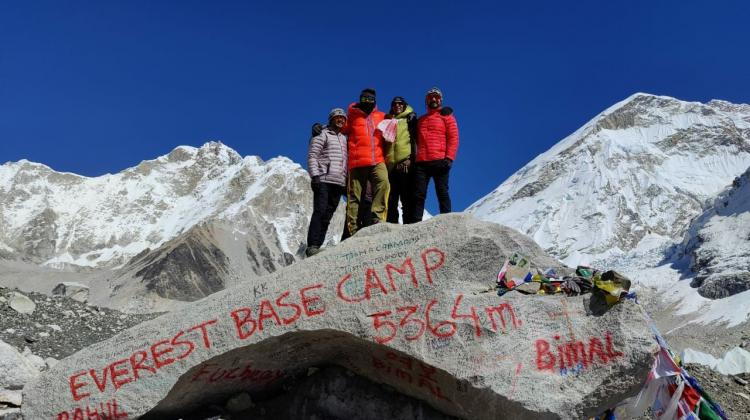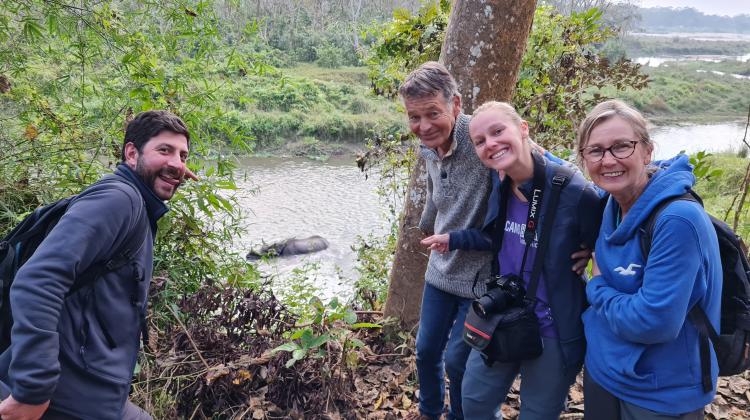Overview
Adventure begins from the famed ancient Gorkha Kingdom in the mid-west of Nepal. The trek follows upstream of the Buri-Gandaki river from the sub-tropical forest to the dry Tibetan zone, offering outstanding views of Mt.Manaslu, the eighth highest peak in the world along with the panorama of the surrounding magnificent peaks that straddle the border with Tibet.
Manaslu is also known as Kutang in Tibetan, and the word is derived from the Sanskrit Manas meaning ‘spirit of the mountain or the soul’ like the Lake Manasarover in Kailash, Tibet, situated more east from the Annapurna and west from Ganesh and Langtang Himal. This mountain was first climbed by a Japanese Expeditions in the early May 09th 1956 by Toshio Imanishi and Gyalzen Norbu.
Manaslu region situated in the central Nepal was opened to western adventures in 1991 but the Mountain itself had been open for the Mountaineering Expeditions
since 1950’s till today. The pioneer headed by H.W. Tilman trekked this region in 1950. The area is still restricted to a limited number of trekkers and it has to be through a proper trekking organization. This region is spectacular with beautiful landscapes culturally fascinating. The locals of this upper area are of Tibetan origin and for some local trader it is just day walk to the Tibet frontier.
Itinerary
Day 1: Arrive Kathmandu.1,300m.
On arrival at Kathmandu Tribhuvan International Airport you will be received by our staff and will escort you to the Hotel, where our guide will give you a brief orientation of the Hotel, Kathmandu, Expeditions, do's and don't and other related information that you might require while in Nepal.
Day 2: 2 days in Kathmandu Preparation of the expeditions:
Two days in Kathmandu for all the paper works and to obtain permits and last minute arrangement for the Expeditions.
Day 4: Drive to Soti-khola 860m.
From here onwards we follow the Buri-Gandaki river upstream, the trail from Arughat are much narrow passing through more rural farm villages and terraced fields with numerous streams to cross in between, the path follows the right bank of Budhi Gandaki, passing through cultivated land, with many scattered farmhouse and hamlets reaching the village of Mordar, Simre and then to Arket. This low trail, which sometimes takes to the river bed is not possible during the monsoon season. After climbing briefly to Kyoropani, then descending once again to the river for the overnight camp at the confluence with the tributary Soti Khola, with time to for a wash in the nearby fresh water stream.
Day 5: Soti-khola to Machha-khola 890m 4-5 hours walk.
From Soti-khola, the path from here at times cuts into the steep valley, which is densely forested, passing through a number of small villages tucked into the hillside, till we reach a widening of the valley, opposite the point where a large tributary stream enters the Burhi Gandaki river. The terraced cultivated fields belong to the upper village of Lapbesi. From here our path descends to the wide, sandy riverbed which follows a trail meandering below the steep, craggy valley side. At length leading to a climb up once again on a track to Machha Khola for the overnight stop outside the village, which has a number of teashops.
Day 6: Machha-khola to Jagat 1,350m 6-7 hours walk.
The trail from from here leads to more interesting farm villages and fields as the vegetation changes slowly, beginning our morning walk crossing the stream that gives its name Machha Khola (Fish stream) and heading upstream to the tiny village of Kholabensi and the hot springs at Tatopani. From here the valley sides becomes steeper, until the path becomes impassable the route then switches to the left bank of the river by way of suspension bridge. After a short section of forest path coming to some teahouses at Doban. Above Dobhan the Burigandaki River flows down in an impressive torrent rapids. Beyond this steep section, the river becomes calmer, meandering across a broad gravel bed. On reaching Lauri we cross the River on a suspension bridge from here leading to a climb on a high path, then descending into open valley at place known as Yara Khola. Here, there many good camping spots depending upon the hours of walk and the condition of the trail. Our journey continues on (if not camping here) for another hour to the village of Jagat. Jagat is quite a big village after Arughat; the people around here are of mixed race Magar, Chettris, Brahaman, Bhotias (Tibetan looking tribes) and some few Newars merchant and shopkeepers. Before joining the main trail of Annapurna, this is the only last big village where most of the merchandize is available from soaps, candy to flashlights batteries etc. Camp is made near village of Jagat after a good walk of 6-7 hours.
Day 7: Jagat to Nyak or Eklebhati 1,775m, approx 5 hours trek.
The trail from Jagat descends to a long series of stone steps to the river, from here the path climbs a terraced hillside to Saguleri, overlooking distance view of Sringi Himal 7,187m from this spot, the walk follows ups and down trail as we reach to the bridge over Buri-Gandaki, after crossing the bridge from Ghata-khola, the path winds up towards Philim village. From here the trails climbs slowly along the hillside passing through small settlements of Aga, Lokwa. After Lokwa it's a downhill to camp at a small place Nyak or at Eklaibhati near Shiar khola with great views looking over the valley towards Pangsing.
Day 8: : Nyak to Ghap 2,156m via Bih. Approx: 6-7 hours trek.
An hour walk after Nyaki, crossing to the east side of the river. The path follows up and down in some section the trail is cut into the sheer cliff walls, after this dramatic portion the track finally improves as the walk leads to Deng village, the houses and terrains completely changes into more Tibetan like from here onwards. The people here are of Tibetan origin along with their ancient culture.
Villagers of this areas cultivates buck wheat, wheat, barley and potatoes as staple crops, beside this since trekking became popular around this area, spinach, carrots and cabbages are also grown. After 3-4 hours of walk brings you at Bih, our journey continues for another two hours on this steep sided and impressive valley, coming across mani prayer stone and finally at Ghap village for the overnight camp which straddles the river across a short wooden bridge. There is a strong Tibetan influence at this village.
Day 9: Ghap to Lho (3,150m) approx: 6 hours trek.
From here onwards the trekking is pleasantly cool as we begin to gain height and enter the alpine forest. The walk continues steeper up as the valley opens out with quite extensive pastures with more steady climb then crossing a large stream flowing down from the Lidana Glacier, with magnificent view of the snow peaks on the north Kutang Himal range with Pang Phuchin 6,335m, and Saula Himal 6,235m and other unnamed peaks of over 6000m. On the southern lies the Manaslu Himal and Simang Himal range with its array of over 7000m peaks. The walk is pleasant; with gradual uphill the altitude gains slowly as you pass through farm villages ShoNamru, Bengsam till the village of Sho is reached. The people from here onwards are engaged in farming during the summer, the young folks in winter travels to trade in big cities Nepal, and India. Just above the village of Sho we get the first views of Manaslu north and then of Manaslu (8,163m) ahead, an hour walk brings us to Lho for the overnight camp. Lho, a large village with a lovely little monastery and nuemrous chortens and Mani walls. Ganesh I is visible, on looking back the way we came.
Day 10: Lho to Sama Gompa (3,500m) approx: 5 hours trek
On leaving the Lho village, trek continues following the river on the right bank, with view of Peak 29 ahead, Two hours of climbing through the forest leads to the village of Shala which offers excellent view of Phungi, Manaslu and Himal Chuli.
A couple of hours further leads us to Samagaon village, with superb view of Mt.Manaslu. Samagaon, one of the biggest village of this region, the people are mostly farmers growing what they could in this harsh terrains and cold climate, like buck wheat, barley are the main crops, potatoes and few varieties of vegetables grow in this soil. The people like their ancestors descended from Tibet as early as 300 years back, the culture and their living style is very much like they predecessor. The people of this area still trade with Tibet taking 2 or 3 days to week. The border to Tibet is a day walk for the locals. It is one of the old salt trade route from Nepal to Tibet.
From here is just half hour walk up to our camp at Sama gompa just above the village of Samagaon. On reaching the camp near Sama-Gompa, we will have time to visit the Monastery one of the major Nyligpa (red hat sect) Monastery of this region.
Day 11: Rest day at Sama Gompa.
Today we will have the well-earned restday, free from packing; a day hike is worthwhile can be done towards Manaslu glacier or near to its base camp.
Day 12: Trek to Manaslu Base Camp. Approx. 4,500m 5 hours trek.
After an easy day at Sama Gompa, today's trek climbs slowly towards the Base Camp the trails meanders on the winding track towards south and beyond. Actually the walk to Base Camp is not too far can be done within 3-4 hours but due to the increase in altitude and the dry air makes the walk a little slower than previous days, need to gain the height slowly taking time and enjoying the view around as you come to the large meadow at the foot of the towering Mt.Manaslu to establish the Base Camp.
Day 13: 15-16: At Base Camp.
Necessary day for acclimatizing and preparations for the long big climb to the summit of Mt.Manaslu.
Day 17: Trek and climb higher to establish the Advance Camp. Approx. 5,600m.
From the campsite cross a high plateau and skirt around the ridge of lateral moraine heading towards the mountain, as the climb progress after 3-4 hours of good walk and climb finding a suitable camp site for the Advance Camp.
Day 18: 18-42: Ascent to the summit of Mt. Manaslu.
Expeditions for 25 days these period allows you to prepare fully with the all the arrangement for the upper camps ferry of the loads to and fro and for the final ascent to the summit on the clear fine morning.
Day 43: Back to Base Camp.
After an adventurous and challenging week return back to Base Camp.
Day 43: Back to Base Camp.
After an adventurous and challenging week return back to Base Camp.
Day 44: 44-48: Trek back to Soti Kohla .
Retrace the journey back to Soti-Kola on the downhill path and reaching to the warm-tropical area.
Day 49: Drive back to Kathmandu.
After all the packing and reloading the gear in the Truck and Bus return journey is made through the new route Dhading as it is more accessible and shorter reaching Kathmandu on time.
Day 50: 51-52 In Kathmandu.
Two days in Kathmandu, this day will allow you for the last hour to shop around
and to prepare the Expeditions report to be submitted to the respective Government Department and for a guided tour around at places of interest.
Day 53: Transfer to Airport for the International departure.
Today as per your international flight time, keep your confirmed air ticket, our Staff will take you to the airport for your final departure from this amazing country, Nepal.


